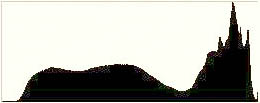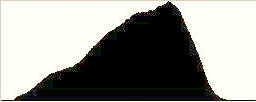| |
| |
| |
| Digital
Outback Fine Art Photography Handbook
© Bettina & Uwe Steinmueller
|
| |
| 5 Using a Digital SLR
in the field (also about Cameras) |
| |
| |
5.0 The Cameras
5.1 The multiplier
5.2 Dust is your enemy
5.3 Exposure
5.4 Know your histogram
5.5 White Balance (WB)
5.6 ISO
5.7 Batteries and Storage for your
images
5.8 The "Every File Twice" principle
|
| |
| |
| |
| This section is not intended to be a
replacement of a manual and/or a good book about digital cameras in
detail. This is section should help you to see the main differences
to regular film cameras and their advantage or disadvantage.
First of all digital SLRs feel almost like the regular SLRs. But then
there are enough differences. The most obvious is that a digital camera
uses no film but captures the images with a CCD or CMOS sensor and stores
the images on storage media (Compact Flash Card, Smart Media Card, Sony
Memorystick, Microdrive or on some other small hard drives) |
| |
| |
| |
| 5.0 Cameras |
| |
| 5.0.1 Brief History |
| |
| The category of what we call digital
SLR's was actually introduced by Kodak. Kodak modified standard film
bodies by Nikon and Canon into digital cameras. Early a 2 MP (Megapixel)
camera was considered high resolution. But even these cameras got very
popular with many journalists. One of my favorite photographers in this
sector is Neil Turner
who I believe still uses a 2MP Kodak camera based on a Canon body.
Then in Fall 1999 Nikon announced it's famous D1 (we got one March
2000) which was the first ever digital SLR designed from ground up.
Of course there are a lot of advantages with having a body designed
for digital and nothing else. Then in 2000 Fuji introduced the S1 and
Canon it's D30 (first SLR based on a CMOS sensor). |
| |
| |
| 5.0.2 Cameras |
| |
| We actually don't want to talk too much
about the cameras as we think you can produce good artwork with all
of them. But of course is the number of pixels (assuming they are close
in quality) a factor which gets important once you want to print big.
Check out our experience reviews and you probably get some understanding
of the different models.
|
| |
| For subscribers we will try to help
them making a better choice (see our subscribers
forums). But first do the following exercise and answer these questions
for yourself:
- What do you want to photograph?
- Speed in terms of frames/second
- Fast autofocus needed
- How large do you want to print?
- Do want to work in Photoshop? (if not forget all of these cameras)
- Do you have Canon, Nikon or Contax lenses?
- What is your price point (don't forget you need more than just the
body)?
- What ISO speed do you want/need?
We know that there are many more questions to ask but at minimum you
need these answered first. Then browse through this handbook and find
out what you want more than just having a camera body.
|
| |
| 5.0.3 Lenses |
| |
| All(!) of these digital cameras will
show best results with the best lenses available. Get the best lenses
you can get. The old rule is still true: Better a low cost body with
great lenses than the other way round.
We regret today all lower quality lenses we ever bought. Also fewer
great lenses are better than many low quality ones. |
| |
| 5.0.4 Tripod & Heads |
| |
| Whenever you can use a rigid tripod and
a good head. Your results will not only be sharper but also better framed.
|
| |
| |
| |
| |
| 5.1 The multiplier |
| |
| Today the CCDs or CMOD sensors for digital
SLRs come in smaller sizes than regular 35mm film. We will keep this
as a fact and not try to find out why because we have to deal with this
fact of life or build our own cameras.
As most of these digital SLRs use normal 35mm lenses (except the E10/20)
the sensor covers only a percentage of the original 35mm film plane.
The crop has a content as if it has been photographed with a longer
focal length. The factor is dependent on the size of the CCD or CMOS
sensor. The larger its size the smaller this factor called "multiplier".
Common today are multipliers of 1.3-1.6. The following table shows
the effect to lenses with different focal length. For a film photographer
the meaning of all his lenses change.
| Multiplier |
14mm |
20mm |
35mm |
200mm |
300mm |
400mm |
| 1.3 |
~18 |
~26 |
~45.5 |
~260 |
~390 |
~520 |
| 1.5 |
~21 |
~30 |
~52.5 |
~300 |
~450 |
~600 |
| 1.6 |
~22.5 |
~32 |
~56 |
~320 |
~480 |
~640 |
Quite dramatic is the change in the wide angle range.
Here many people long for a full sized sensor. For us it is not such
a big deal as we do not use extreme wide angle that much. Our 17-35mm
lens gives us enough wide angle. On the other side for wildlife photographers
this works like a free tele extender and a full sized sensor would lose
all that advantage. |
| |
| |
| 5.2 Dust is your enemy |
| |
| There is a downside of digital SLRs
with interchangeable lenses. As we open the camera to change the lens
dust can enter the mirror chamber and get onto the fine structure of
the CCD or CMOS sensor. Using just a bulb blower as suggested by Nikon
and Canon (although the D30/D60 seem to be less prone to dust) just
does not work and while Kodak and Fuji support the cleaning with "Sensor
Swabs" this is not at all allowed by Nikon and Canon.
We all hope "there is a way" but till then everyone has to deal with
it his own way. Here the Olympus E10/20 have a selling point. They use
a sealed fixed zoom with the following advantages:
- Sealed camera stops dust
- The lens can be optimized for digital
By the way in about latest 5-10 years all lenses will be optimized
for digital once digital dominates the market. While the Olympus approach
is very interesting there is of course a price to pay:
- Canon and Nikon deliver a much wider range of high quality lenses
- Nikon and Canon dominate the professional market
- The CCD in the E10/20 is smaller which introduces some more noise
for the photos.
|
| |
| |
| 5.3 Exposure |
| |
| The contrast today's digital SLRs can
handle is about the same as chrome film. The consequence can be easily
blown out highlights. We all would like to have a contrast range which
comes close to negative film and would be more forgiving with overexposures.
Also underexposure is not really desirable as underexposed shadows show
more noise
Rule: Never blow out your highlights because what
is lost cannot be re-created. |
| |
| |
| 5.4 Know your histogram |
| |
| But here is help which only the digital
camera can provide: All digital SLRs provide a way to view the result
of the last photograph taken and show a histogram of the the gray scale
values from 0 (black) to 255(white) (The histograms of Kodak's 760 and
ProBack show values relative to neutral gray).
We will show 3 histograms (here taken from Photoshop) and comment there
characteristics.

Here the highlight (right side of the histogram) are just
lost. Only in very rare cases this would not be a candidate for delete.
Some might recommend to "burn" the photo in Photoshop. But still that
is faking details in the highlights which are not there.

Here is only a small spike in the highlights and it very
much depends on the photo whether this might be a problem or not. If
the spike represent a real pure white or an unimportant detail than
this photo might be still OK. But otherwise we are in trouble.

Here the highlights are OK. We lost a bit bit of the dynamic
range in the highlight area but this can be corrected in Photoshop.
You should aim for histograms like this. Again: don't blow the highlights.
Of course the histogram only helps if you can repeat
the shot. Fortunate in nature photography this is often the case except
for photographing birds and other wildlife. Unfortunately even the sophisticated
exposure measurement of today's cameras is often not good enough to
get perfect exposure very time. Probably many photographer are better
in good exposure metering than we are but watching for the histogram
gives us a great tool. If we have an overexposure we dial in an EV compensation
and repeat the shot. We watch the histogram all the time and some digital
SLRs allow the display of the histogram automatically after very shot.
If we work from a tripod we only use manual exposure as
is is easier to correct exposure than using EV correction and also often
the right values don't change that often if light is the same while
the camera metering might just change because of the scene. |
| |
| |
| 5.5 White Balance (WB) |
| |
| With film you care about the white balance
by choosing different types of film or use filter to compensate for
different light (indoor, sun, cloudy, shade, flash, …). Getting the
WB right is key to correct colors.
We only use RAW file formats with the different cameras (see discussion
later) and in this case the WB can be quite efficiently corrected later.
For fine art photography not really the true color counts (would someone
use Velvia for that?) so we are more interested in the subjective correct
WB.
Digital SLRs allows to measure the right WB at the time you photograph
which might be optimal but is also not too easy in the field (nature).
So we mostly set the WB to some fixed setting (which is e.g. "daylight"
for our Nikon D1x) and adjust the WB later. Also a very good practice
is to photograph a photo with a gray card (or even better a Macbeth
ColorChecker) in the same light as the following photos and use this
photo later for the right WB correction.
Correcting WB (and color in general) is very tricky, needs a lot of
experience and we would not even think of being a master here. But with
practice you get better.
Also one thing has to be observed: The judging of colors is very much
a function of mood. Sometimes colder colors (more blue) are found and
then your want more warmth (more yellow) and all these experiments add
up to a lot of time optimizing your images.
If you sometimes feel lost. Don't worry you are not alone! |
| |
| |
| 5.6 ISO |
| |
| All the digital SLRs allow to change
the ISO value on the fly by just dialing a new value. This is a big
plus of digital because you can change ISO speed picture by picture.
But like in the film world there is of course no free lunch. Lower
ISO means lower noise (better image quality) and higher ISO higher noise
(lower image quality). Noise can show in many different ways. If a camera
shows the noise like some more or less grain than this is very positive
as we are used to grain from our film based experience. |
| |
| |
| 5.7 Batteries and Storage for your images
|
| |
| |
| 5.7.1 Batteries |
| |
| Unfortunately the digital cameras need much
more power than the film cameras. These are quite powerful little computers.
Staying away from some car or electric outlet for longer than a day can
be a pain and you might need to carry special batteries (3rd party accessory).
|
| |
| For some batteries (e.g. NiMH packs)
it is nescessary to decharge/charge them properly to get maximum output.
See the references section below for more information.
If you need more power than your camera can supply (longer disconnected
from any recharger or using other devices like flash and digital wallets)
you might look at other large capacity batteries like Qantum or the
Digital Camera batteries (allso see references below) |
| |
| 5.7.2 Storage |
| |
| Also you need to store your digital
images. Example: My Nikon D1x uses per compressed RAW images about 4MB
and other SLRs might even need more space. So shooting 250 images will
need at minimum 1GB of storage. The cheapest solution so far per MB
is a Microdrive and we carry with me about 3.2GB storage on IBM Microdrives.
This is easily enough for us for a day but not for a week. In the case
that you are longer away from your computer than your Microdrives can
hold you need a digital wallet which can store 10-20 GB of files.
Aren't Microdrives more error prone than compact flash cards? Probably
they are. So if you want to be more on the safe side than you need to
spend more money to invest into CF cards. The Nikon D1 did not officially
support the 340MB Microdrive and some people (including us) experienced
some sort of trouble. We lost about 4 photos due to some MD failure.
Bettina once lost some more files but only because she did not watch
properly the image counter. Keep an eye on the counter to ensure that
the file as properly written to the card or Microdrive.
As film can be lost in the mail also digital files can be lost for
many reasons:
- The card get corrupted (often bad sectors)
- You format a card which has not yet beenw downloaded
If this desaster happens to you you need
special tools for recovery:
- better do not(!) use Norton utilities as they
may damage data that be used by
- use "PhotoRescue"
| PhotoRescue (Data Recovery from deleted
or corrupted CF Cards)
Fortunately we currently had no real damaged
CF card or Microdrive. So we took a fresh formatted (formatted
in the Nikon D1x) 1GB Microdrive and looked what PhotoRescue would
find on this card.
PhotoRescue found 167 NEF files from our last
4 outdoor photo sessions (which means it had been also 4 x formatted).
Only 3 of these NEF files were not usable anymore. We agree with
other reviewers that PhotoRescue can be a life saver for otherwise
lost photos. We would recommend to use PhotoRescue before analyzing
the CF card with other tools like Norton or Scandisk. Norton and
Scandisk might repair the structure of your card/disk but could
also make small changes which prevent PhotoRescue to recover valuable
photos.
Download a trial version (PhotoRescue can be
registered later) (PC/Mac)
Order PhotoRescue for $29 from here (PC/Mac)
|
|
| |
| 5.7.3 Digital Wallets |
| |
| Digital wallets are devices which can
store digital files in the field and are smaller than any notebook and
also have more capacity than compact flash cards or even Microdrives.
I would suggest that you have enough cards (CF or Microdrives) for a
day of shooting (we have about 3.2 GB in Microdrives and rarely do more
than 1GB a day).
If you the stay longer than one day and have no laptop with you then
you need a digital wallet. We would even argue that you need two digital
wallets and also be nice to them. Why two? Let's just think you are
for a week in the field and fill 15GB of disk and this disk crashes.
You get the answer? What if a Microdrive crashes? Than you had a bad
day. But 15GB is a much bigger disaster than just 1GB. |
| |
| Tip: Watch
the download to the wallet very carefully that you don't miss any error
during the transfer. Why could it fail?
- Battery low
- Corrupted sectors on the card
- Error in the unit
- Wrong file system on card (e.g. 32bit FAT as the Kodak cameras can
read/write)
|
| |
| |
| 5.8 The "Every File Twice" principle |
| |
| Your digital files are your digital "negatives".
If you lose them the photo is gone forever. The good news is that a copy
is easily made and has the same quality as the original. That means make
as soon as possible a copy. An always keep the copies on two different
media and even better at different places. We come back to this later.
|
| |
| |
| |
| © Bettina & Uwe Steinmueller |
| |
| |
| |
/
/
/
/